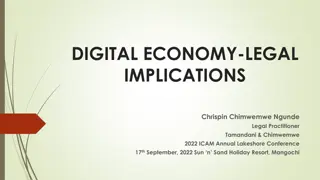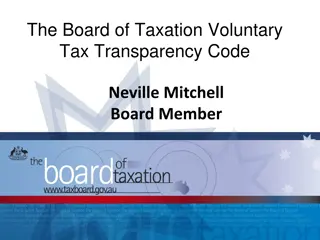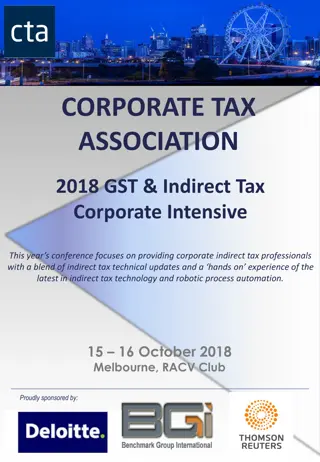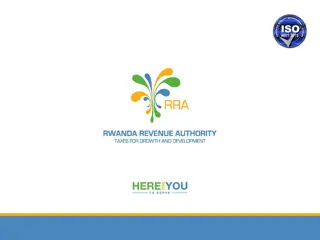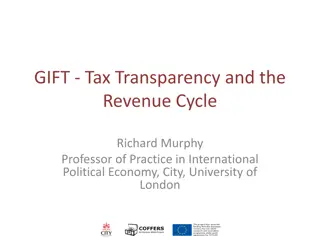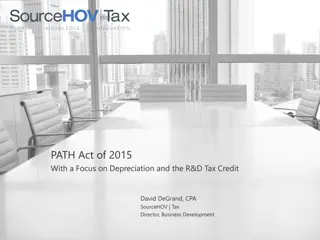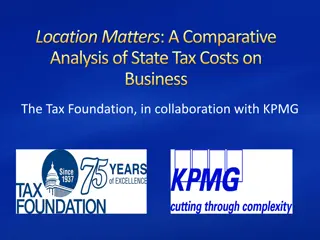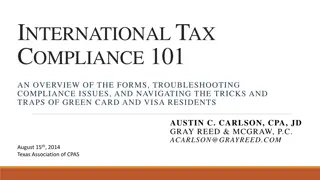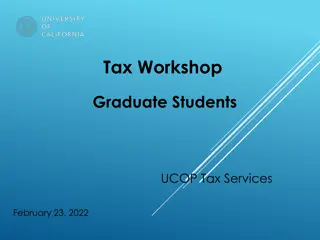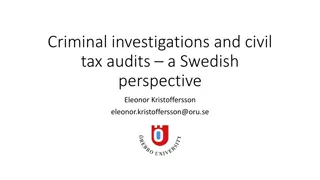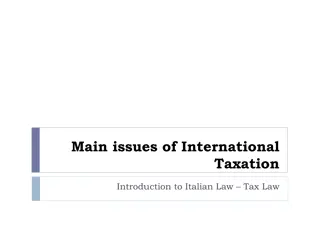International Tax Conference 2019: Digital Economy & PE Attribution Issues
The International Tax Conference 2019 discussed the challenges of the digital economy, profit attribution to Permanent Establishments (PEs), and tax issues related to technology companies. The event covered topics such as nexus connection, data value attribution, and income characterization in the digital business landscape. It also highlighted the impact of E-commerce, user participation, and the journey of addressing tax challenges in digitization. The event showcased key developments in international tax laws and India's draft rules for profit attribution to PEs in the digital era.
Download Presentation

Please find below an Image/Link to download the presentation.
The content on the website is provided AS IS for your information and personal use only. It may not be sold, licensed, or shared on other websites without obtaining consent from the author.If you encounter any issues during the download, it is possible that the publisher has removed the file from their server.
You are allowed to download the files provided on this website for personal or commercial use, subject to the condition that they are used lawfully. All files are the property of their respective owners.
The content on the website is provided AS IS for your information and personal use only. It may not be sold, licensed, or shared on other websites without obtaining consent from the author.
E N D
Presentation Transcript
Plenary 2 1 INTERNATIONAL TAX CONFERENCE 2019 International Fiscal Association & International Bureau of Fiscal Documentation (IBFD) April 26-27, 2019 The Lalit, New Delhi Digital Economy The emerging PE and attribution issues
Table of contents 2 Sr No Title Slides 1 Digital Economy 3 to 7 CBDT Committee on profit attribution to PE 2 8 to 11 3 Points for Panel discussion 12 to 17
3 Digital economy
Tax issues | Where it all started 4 Technology companies have been making headlines for their perceived tax structures Google, Facebook, Amazon, Apple Companies not paying their fair share of taxes Failure of traditional concept of PE Business world now largely dominated by digital companies who earn revenues from jurisdictions where they do not have a physical presence thus, at times, making it unclear as to where the revenue generating activities take place Key issues concerning digital economy 1 1 Nexus Connection between the activity and the country 2 2 Data Information collected digitally which supposedly creates value for MNEs. Attribution of value to use of data not clear 3 3 Income characterization Business income/ royalties/ FTS
Digital economy Business models 5 E-commerce Three features of highly digitalized businesses Participative networked platforms Online advertising Scale without mass Digital economy Use of intangibles User participation and data and their synergies with IP App Stores Online payment services
Digital economy The journey so far 6 Interim report on digital economy released Public comments released BEPS Action Plans submitted FEB 2019 OCT 2015 MAR 2019 JULY 2013 MAR 2018 Addressing tax challenges of digitization - Public consultation document released BEPS Final Package of Measures released
Digital economy | India 7 Draft rules for profit attribution to a PE (including in cases of digital economy) released for public comments in April 2019 Significant economic presence test introduced in 2018. Expands the scope of business connection to cover digital businesses/ agency functions based on revenue/ user thresholds (which are yet to be prescribed) Equalisation levy @ 6% introduced in 2016 Separate levy for specified services (online advertising, etc) Definition of royalty expanded to assert source based taxation for payments towards online databases, satellite related payments, etc Short term solution followed by long term consensual overhaul of tax system looks like the game plan for taxation of digital economy
8 CBDT Committee on Profit attribution to a PE
CBDT Committee on Profit attribution to PE (1/3) Key highlights and recommendations 9 Users (though not remunerated financially) create value and profits for an organisation and hence can be equated with employees, workers, vendors, etc Report recognises that degree of user participation can vary from businesses to businesses The Report also recognises that user participation can be passive or active . Even the intensity for active user participation can range from high, medium and low. However, no guidelines or objective tests have been recommended to determine the intensity of user participation
CBDT Committee on Profit attribution to PE (2/3) Key highlights and recommendations 10 Profits derived from India to be higher of: (a) Amount arrived at by multiplying the revenues from India with the global profitability margin (EBIDTA margin) (b) 2% of revenues derived from India The aforesaid profits to be multiplied with a multiplying factor (based on following prescribed weights for sales, assets, employees and users) in order to determine the profits attributable to operations in India Weights across categories Sales Manpower 1/3 1/6 Types of business models Employees Assets Users Wages 1/6 (a) Non-digital business models (b) Digital models with low/ medium user intensity (c) Digital models with high user intensity 1/3 N.A. 0.3 0.15 0.15 0.3 0.1 0.3 0.125 0.125 0.25 0.2
CBDT Committee on Profit attribution to PE (3/3) Key highlights and recommendations 11 For example: Profits attributable to Indian operations for a high user intensity business model is recommended to be arrived at as per the following formula: * 0.3 * SI/ST + 0.125 * NI/NT + 0.125 * WI/WT + 0.25 * AI/AT + 0.2 Profits derived from India# SI Sales revenue derived by Indian operations from sales in India ST Total sales revenue derived by Indian operations from sales in India and outside India NI Number of employees employed with respect to Indian operations and located in India NT Total number of employees employed with respect to Indian operations and located in India and outside India WI Wages paid to employees employed with respect to Indian operations and located in India WT Total wages paid to employees employed with respect to Indian operations and located in India and outside India AI Assets deployed for Indian operations and located in India AT Total assets deployed for Indian operations and located in India and outside India 0.2 Weight recommended for user participation for high user intensity business models # Revenues from India multiplied by Global profitability ratio or 2% of India revenues; whichever is higher
12 Points for Panel discussion
Points for Panel discussion (1/5) 13 Source v. Residence conflict General position has been to differentiate between doing business with a country and doing business in a country. Is that distinction dead now? Data and user participation One of the 3 prevalent features of highly digitalized businesses (apart from scale without mass and heavy reliance on IP ) Does data and user participation contribute to value creation ? Data itself has no intrinsic value Reliability, veracity and materiality of data? Distinction between active user participation and passive user participation ? Also, how does one distinguish between high , medium and low active user participation as suggested in the draft report by the CBDT Committee?
Points for Panel discussion (2/5) 14 Significant economic presence (SEP) test Given that equalisation levy was already in place, was there a need to introduce the test of SEP? Could India not have waited till emergence of full consensus at OECD? Language of SEP test is quite wide to even include non-digital activities. Thus, a mere sale of goods or rendering of services by a non-resident to Indian customers can potentially create a taxable presence. Will SEP test address India s concerns or will simply lead to more uncertainty and litigation? What happens to existing litigation on website being a PE? Does this imply that prior to amendment, a digital presence did not create a taxable presence? Practical challenges for instance, withholding tax obligation, difficulty in obtaining information from non-resident to determine SEP, etc. Is gross-up @ 43% inevitable? Revenue and user thresholds to determine SEP not yet prescribed. How does a taxpayer deal with this?
Points for Panel discussion (3/5) 15 Profit attribution Formulary approach recommended by the CBDT Committee (refer slide 11 for illustration) Impact on pending litigation on PE and income attribution? No cognisance for losses on account of minimum 2% income attribution. Isn t this unfair? How to distinguish between digital and non-digital business models? No tests prescribed How to determine active v. passive user participation? Also, how does one determine the intensity of active user participation (high, medium and low)
Points for Panel discussion (4/5) 16 Nexus and profit allocation rules Will not the BEPS work (under Action Plan 8-10) address the issues arising out of intangibles? Although all countries have agreed to undertake a coherent and concurrent review of the profit allocation and nexus rules and work towards a consensus based solution, how the OECD will bridge this gap before the 2020 deadline remains to be seen. Equalisation levy Has equalization levy achieved the objectives for which it was enacted? OECD report also stated that any interim measures ought to be in compliance with countries international obligations (including tax treaties); which is not the case with equalization levy
Points for Panel discussion (5/5) 17 Tax trade war US has undoubtedly opposed to reforms suggested by OECD and the EU as it does not believe that digital businesses are sufficiently unique to warrant a separate tax treatment This casts significant doubt on prospects of OECD successfully being able to introduce consensual changes in this area. Thus, if reforms are enacted on a unilateral basis, will it trigger a tax trade war?
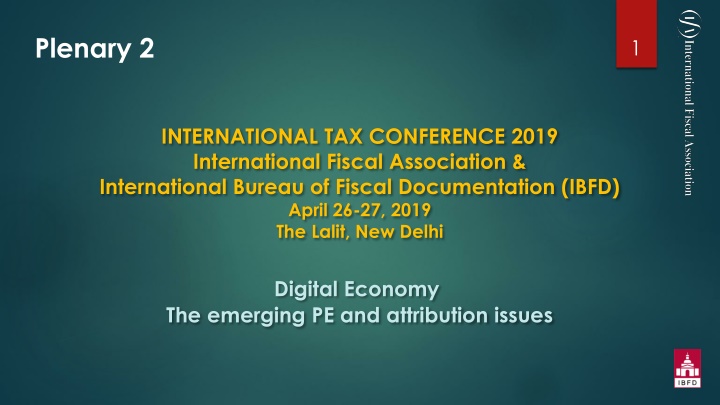


![Town of [Town Name] Real Estate Tax Rates and FY 2024 Budget Summary](/thumb/62211/town-of-town-name-real-estate-tax-rates-and-fy-2024-budget-summary.jpg)


